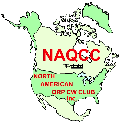
 | NAQCC News |
| Aug 29, 2009 | NAQCC Web Site | Issue #101 | |
|---|---|---|---|
| In this issue: 1. September Challenge. 2. August Sprint Results 3. General Club News 4. Elmer Project 5. Latest Award Winners 6. News Items and Articles by Our Members |
| 1. SEPTEMBER CHALLENGE: This challenge is the second running of our state number challenge. A state/number combo means working a station with the number 1 in his call in CT counts as CT/1. A 4 in AZ would be AZ/4. You can only count a combo once. No matter how many 1's you work from CT, that is still only one CT/1 combo. Each state can have 10 combos for a maximum of 50 x 10 or 500 total combos, although some numbers may or may not be used in AK and HI. A certificate goes to the two stations working the most state/number combos. As you should do for every challenge, sprint, and award, read and understand the rules completely before you do anything. Here in the newsletters we just give a brief synopsis of what's going on. Full Challenge info here. 2. AUGUST SPRINT RESULTS: This was a strange sprint with conditions seemingly very good, but participation down. 49 logs received is the first time under 54 logs since February and only the second time under 50 since June of 2008. There were a lot of stations that showed up in cross-checking (90 in fact), but a lot of them obviously didn't send in logs. Here in PA I found 20 to be useless, 40 quite good, and 80 good although not many showed up on 80. Most of the stations I worked on 80 had as strong a signal as I've ever heard from them before. Our special award needs comment and clarification. We had two SA's this month, one for the oldest participant and one for the youngest. However so few chose to give their age (I thought that was reserved for the female half of the population, but all our 49 participants were male this month) that in a couple divisions, the same person competed for both oldest and youngest. Fittingly however, the drawing wound up completely at random choosing the overall oldest W9WOC (79) and overall youngest W6GY (45) as the winners. I recall only one station who didn't use the autologger this month, and that made log checking much easier for me. However many are still repeating the same annoyances I reported last month, so I'll repeat them here hoping you will correct them for your September log submission. 1. In the new multiplier column of your log, number the new mults consecutively and if it's not a new mult, put a hyphen (-) there. 2. Do NOT put a colon (:) in the time, for example 0127, NOT 01:27 - NOT 1:27. Include the leading zero. 3. If you're competing for the special award certificate, be sure to fill out the two appropriate fields in the autologger as instructed in the rules for that particular sprint. You may think I'm being picky, but you'd be surprised how much time it takes to correct such 'picky' things to get ready for log cross checking. Thanks in advance for following the above steps. Here now are the full statistics for the August sprint. STATS - current month, previous month, all time record, mo/yr (blue indicates a record set this month): Aug Jul Rec Month Logs - 49 54 65 5/09 & 4/09 Autologger logs - 48 52 59 5/09 Stns in logs - 90 87 110 5/08 Hour 1 QSO's - 328 333 564 9/08 Hour 2 QSO's - 249 257 476 9/08 Total QSO's - 577 590 1040 9/08 20M QSO's - 80 116 209 6/09 40M QSO's - 458 429 720 5/09 80M QSO's - 39 45 481 12/07WINNERS: 1st SWA East - K3WWP 1st SWA Central - K9PL 1st SWA Mountain - W6GY 1st SWA Pacific - KA7SPS 1st Gain - K4BAI Special Award (Oldest and youngest participants) Drawing Entrants: (Oldest) VE3FUJ W9WOC W6GY K4BAI Drawing Entrants: (Youngest) K3WWP W9WOC W6GY NG7Z Drawing Winner: (Oldest) W9WOC Drawing Winner: (Youngest) W6GY Congratulations to all including winners and non-winners. Actually everyone who participated and sent in a log is a winner because that shows the ham radio world that there are many folks still using and enjoying CW on the ham bands. That's one of our main goals here at the NAQCC. Very special thanks to those who reported their results even though they made only a few QSO's. Your reports are important also. We had a very high total of 11 stations who didn't submit a log show up 5-19 times in the 49 logs we received and cross-checked. Hopefully those 11 and many others will be back next month AND submit a log. Remember submitting a log doubles the strength of your statement that you support CW operation. We welcome these hams who submitted a sprint log for the first time. We hope they will continue to participate and report their results: VE4AEO(nm),K8CN(nm),WA9ZES,AA7EE,KC0GIO,WB3DSJ. (nm=non-member whom we hope will join soon) Since the 1960's K4BAI has been one of the very best contesters in the world, and I'm delighted he participates in our sprints regularly. I'm glad he does it in the GAIN category most of the time, as otherwise I'd have no chance of ever winning the SWA category EASTERN division. I'm also proud to say we've been friends since the 60's although we've never met personally. To get to the point after that preamble, I feel honored both personally and for NAQCC policy on log checking to receive this note from K4BAI after I pointed out a discrepancy in his log, "Thanks, John..... Glad you do such a good job of log checking. 73/72, John." Full sprint info here. 3. GENERAL CLUB NEWS: If you haven't been on a sub, perhaps this picture of the entire radio room will give some idea of the cramped space aboard a WWII-era sub. 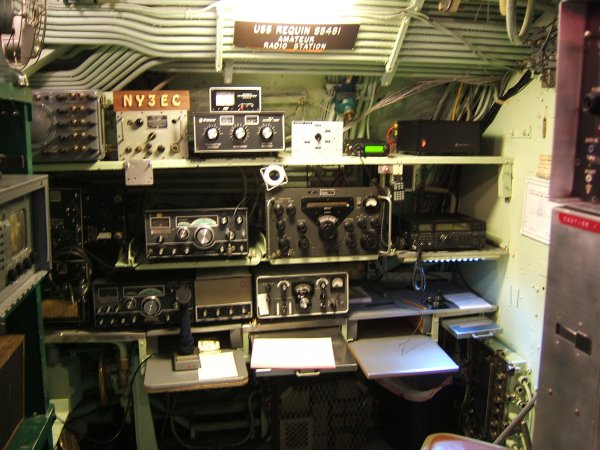 Obviously most if not all the gear shown there is ham radio gear rather than the original radio gear on the Requin. I'm sure some classic ham gear collectors are salivating at the picture of some of those rigs in superb condition. It seems like every time Tom WY3H and I (John K3WWP) head to Pittsburgh, we run into a massive traffic jam. This time it was due to some kind of a medium sized grocery truck that was involved in a wreck that scattered groceries and broken glass across the roadway, bringing traffic to a slow crawl while it was cleaned up. As a result we missed our planned starting time of 10 AM EDT, and didn't get on the air till around 10:45. Tom took his Century 21 rig which we hoped to use, but for some reason we could not get a good match to the Requin's antennas. After wasting some time trying, we decided to use one of the Requin's ICOM rigs. This presented another problem. That rig doesn't go below 10 watts, so we weren't able to operate QRP as intended. We apologize to anyone who wanted a 2X QRP QSO with the sub. Since we couldn't go QRP, we made the decision to just crank up the power on the rig to around 70 watts or so to make it easy for those working us. Here's Tom and John busily making QSO's once we got set up. 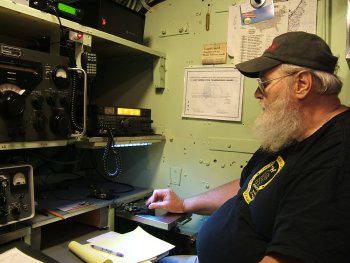 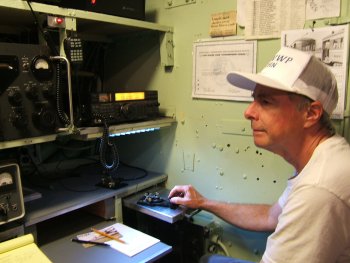 It was easy making QSO's. In fact I commented to Tom that I'm glad I use only QRP, because making QSO's with QRO was just too easy and not all that satisfying. However, I am delighted that Tom and I were able to give those of you who wanted it, a QSO with the Requin. All QSO's we made will be verified with a picture card of the Requin. We must apologize to anyone who may have called us whom we didn't hear. The QRN aboard the Requin was just about unbearable at times on 40M and we never could find any filter that worked to make it better. Even with the noise though, we were making a fairly steady stream of QSO's on 40. However since we promised to operate both 40 and 20, around 1:30 PM we moved from 40 to 20. The noise there was much lower, and it was nice to give our ears a rest for the final half hour of operation with some easy solid copy QSO's. Here's a list of all the stations we worked. Those without a NAQCC number are non-members whom we will recruit to become members. W2IFB, W8FS, N2COD 0554, WA3ZBJ 1905, N8ZYA 2279, KA2KGP 0555, KO1E/M, KC9MTP 3846, K8HW 2236, K4ENC, VE3ABC, W1DV, W5BOS, W2GS, W1PID 0436, W9TFC The time went all too quickly, and it was time to pack up and come home. We must thank all those manning the Requin and helping us with our operation. Every one was well trained in what they were doing, from the young lady who greeted us as we arrived through the ham who helped us get set up and going, despite also being one of the tour guides and dealing with a multitude of other things as well. I wish I could mention all their names here, but I don't have names for everyone. One who helped us carry in our gear is named Anatoly. The ham who helped us is Art WA3BKD, and he went way above and beyond the call of duty in helping us. It was also a delight talking with him about life aboard the submarine as well as ham radio matters. Just to pick out one topic to mention, he told us that the average speed of CW on the sub when it was on active duty was around 15 WPM. Then in response to my question about an Aldis Lamp, he said the speed with that device was around 5 WPM. Tom and I both hope we can get to do this again some time. Thanks to all who worked us in the three hours or so we were active as N3AQC/MM. It didn't really strike me at the time because there was so much involved, but after the experience I felt a feeling of awe at having actually operated from the radio room of a submarine where many much more important messages than ours had been sent in some very serious conditions on or under the seas. Hi there, DE WY3H. As for my "02 cents worth" the Requin operation was for us the experience of a lifetime. Last year my son Ethan, W3IRS, and I each had a QSO with a special event station, N9N, Groton, CT. This station commemorated the 50th anniversary of the historic and astounding journey of the newly commissioned nuclear submarine, USS Nautilus under the North Pole ice cap in 1958. When the Nautilus emerged on the other side of the ice cap, a simple CW message was sent to a naval radio station in Hawaii: "Nautilus 90 North," hence the special event call, N9N. The QSO prompted me to buy the book "The Ice Diaries" by Nautilus commander Capt. William R. Anderson and co-authored by Don Keith, N4KC. That special event station culminated in more than 2,000 QSOs with radio amateurs in all 50 states and 26 foreign countries. The Nautilus journey was one of the major U.S. victories in the Cold War. It is now dry-docked in Groton, CT. I learned that submarines such as the Requin could never have made such a journey simply because diesel-powered subs had to surface about evey day or so to recharge batteries and get a new supply of fresh air. Nuclear poswered subs such as the Nautilis (astoundingly larger than subs like the Requin) could stay submerged for months and compared to the older WWII submarines, were almost luxury liners. To have served aboard the Requin or similar diesel-powered subs is a testimony to the resiliance and tenacity of our U.S. Navy submarine veterans. I might mention that operating radio aboard the Requin is not for the claustrophobic. The aisleways are quite narrow and quarters are cramped, to say the least. However, the experience may prove to be the thrill of a lifetime for anyone who has never served on a submarine. Anyone in or near the western Pa. area who would like to tour the Requin or operate the sub's radio room should contact Art Muller, WA3BKD, by calling 724-356-7381. Art, a retired Navy radio operator, has been guiding tourists and overseeing the radio room on the Requin for more than 20 years. By the way the Requin's official U.S. Navy radio call was NYEC. Today the call of the Requin's amateur station is NY3EC. Listen for Art or other operators on the CW portions of 40 and 20 meters on Thursdays or Fridays at various times, late a.m. or early p.m. (local) Eastern time. We've started sending out our informational emails to all ops informing them of specific things they need to know about the operation. Thanks to Bill W0EJ, we have a beautiful prize item which we have decided to give away in conjunction with our anniversary celebration. Every one of our club members will have an equal chance of winning a 'CW Lamp' built by Bill and donated to the club. A picture is worth a thousand words, they say, so here is a long description of the lamp. 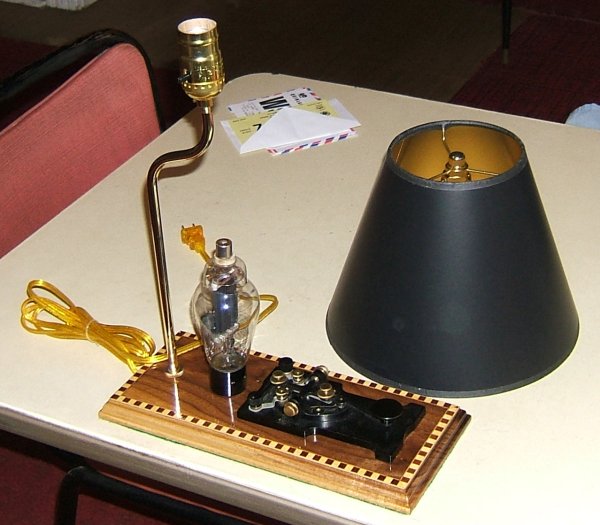 To win the lamp, you must be the MEMBER who makes the most different call-band QSO's with our special event stations. Those who operate our N#A stations as well as club officers are included in the competition for the lamp. Contest, sprint, and net contacts DO NOT count so as to give everyone the equal chance we mentioned. To clarify, call-band QSO's work like this. If you work the following, N3A 80M, N2A 20M, N1A 30M, N3A 30M, N7A 10M, N2A 20M then you have 5 call-band QSO's. Each different call-band combination counts once. The second N2A 20M is a duplicate and does not count. In case of a tie, it will be broken by the following: 1. The one working the most different N#A stations 2. The one including the most different bands in working stations 3. A drawing We'll be updating our anniversary page in the main section of the web site very soon now with all the info you need to know about this year's celebration. The bug arrived a couple days before posting this newsletter, and I took this picture of it on my shack desk after adjusting and trying it out for a while. 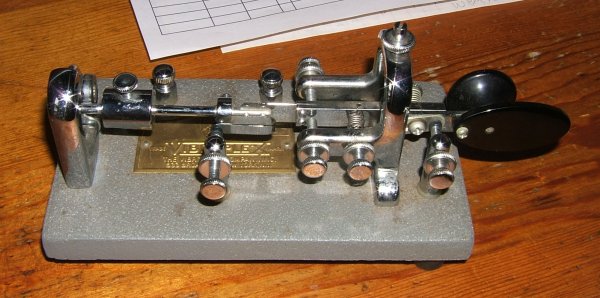 Tom and I decided to give it away to someone who is very active in club events. We'll award points for things like participating in our sprints and challenges, earning our awards, and recruiting new members to the club. Those are some very valuable services a member can offer to a club, and such dedication should be rewarded. Final details in our next newsletter. 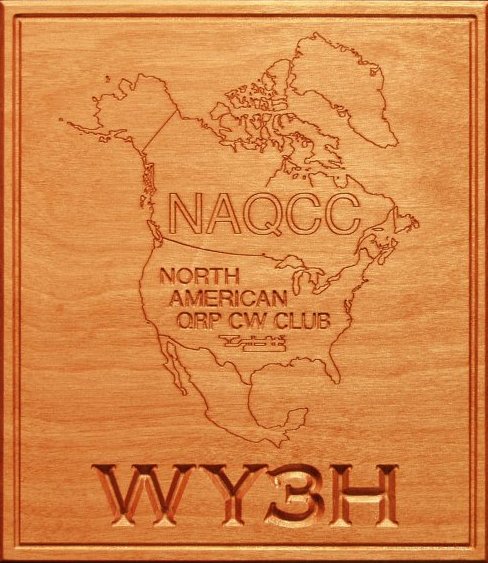 The info on this was just finalized as this newsletter was 'going to press' and there will be more about it in the next newsletter and on the web site soon. 4. ELMER PROJECT: From John K3WWP - We've finally initiated our Elmer Project section of the club web site. It is a re-naming of the CW Operating Tips section with additional info that will be provided by Karl N3IJR and Ron K5DUZ as soon as possible. Of course all the CW tips pages will remain there as well. Don't forget our NAQCC QRS Net that meets each Sunday evening on 7.122 MHz at 8:30 PM EDT. NCS is Karl N3IJR, our Elmer Project co-director. Alternate NCS is our President Tom WY3H. Karl will be sending a net report for each end-of-month newsletter listing check-ins for the month as well as other comments on the net. Remember also that Karl has a list of Elmer's who are willing to help on an individual basis, all you have to do is drop Karl an e-mail to Our Elmer project is starting to roll now, and we need you to keep up the momentum. If you are interested in helping out or need help with any CW and/or QRP matters contact: K5DUZ - N3IJR - Also see Elmer Project on the web site. 5. AWARD WINNERS THE PAST TWO MONTHS: CERTIFICATES: 1000 MPW: #0059 - NB4M #0060-#0065 - W6AZ 30-30 Magnum: #0005 - NU7T Alphabet Prefix: #0009 - W6AZ Suffix Words: #0003 - WY7N - SWA Category WAS: #0010 - W6AZ ENDORSEMENTS and/or WEB SITE LISTINGS: 2XQRP: N8ZYA - 100 pts - Web site listing KMPW 100 Honor Roll: K3WWP - 395 - SWA W6AZ - 201 - SWA Alphabet Prefix Honor Roll: W6AZ - 202 - World W6AZ - 100 - USA Suffix Words Honor Roll: WY7N - 50 - SWA Category Worked Members Advanced: K3WWP - Endorsed for 1300 points Remember our incentive to work towards and earn our NAQCC awards thanks to Gregg WB8LZG. Gregg has donated a set of beautiful knob inserts for the K1 and K2 rigs. The Prizes page in the main QSO-A-DAY 30-30 Alphabet Prefix Worked Members - Advanced Suffix Words Check the 'Current' page in the 'Awards' section of the web site for rules for these awards. Only new applicants on or after October 1, 2008 are eligible. Full List of all award winners here. 6. NEWS ITEMS AND ARTICLES BY OUR MEMBERS: This section is a forum for you to tell other members what you've been up to on the ham bands or to submit an article dealing with some aspect of CW and QRP operation or equipment. Send your news items and articles to our news editor Paul KD2MX at DISCLAIMER: Any views expressed in this section are those of the member submitting them, and may or may not be those of the NAQCC or its officers. I was spending time playing computer chess with a neighbor and didn't get to my shack for my streak QSO till about 0150Z. Normally I get there shortly after 0000Z. I tuned on 40 and tried a couple CQ's with no luck, then decided to see what was on 30 meters. I tuned down from 10120 hearing nothing until reaching 10103.5 where I heard KL7J K. Without even stopping to check if that was at the end of a CQ or in a QSO, I sent K3WWP, got a reply K3W?, sent K3WWP K3WWP, got a K3WWP 449, and with that a 14 year quest to finish WAS on 30 meters came to a successful end. Of course I could have made a sked with some AK station and gotten it a lot earlier, but I don't like to do things that way. I like to just tune the bands looking for what I need or call CQ and hope something comes along. It's a lot more fun and satisfying that way. Oh, and exciting also!. July was a memorable month for me because it marked my completion of a three-year, home-brew amateur radio project that did not use solder, wire, or electronic components. This just-completed 21st Century home-brew project (more properly called "desk-top publishing") resulted in an e-book about a more traditional, 20th Century home-brew project that used solder, wire and vacuum tubes to build a double conversion super heterodyne receiver. Completed in 1967, this reciever is still functional today (along with several hundred of its kind). Last century's home-brew undertaking was part of the Ted Crosby HBR receiver series of 1957 - 1970. I was one of Ted's "inner circle" in the last years of the HBR era. I may indeed be that circle's last survivor. My recollections of those times, plus a collection of over 100 letters from Ted, have resulted in "Recollections of a Radio Receiver", a 580 page e-book on CD-ROM, that tells the Crosby HBR story as I experienced it 50 years ago, and as it still exists today. In many ways, this unlikely adventure of Ancient Amateurs mixes well with QRP, CW and all those other "forgotten" but still both functional and fascinating amateur activities still enjoyed today by NAQCC members. For more on the subject look at my web page www.w6hht.com. In between some really great vacation activities, I was able to enjoy 29 QSOs on 20, 30, and 40 meters. I worked 12 states, 2 Canadian provinces, and 2 DX - Spain and the Dominican Republic. My antenna was a 40-ft vertical wire tossed up into a pine tree just off the back deck of the place where we stayed. I also had three 16-ft counterpoise wires laid out on the ground. A group of very frisky squirrels were frequent guest operators. They were eating pine nuts out of the cones hanging in the trees and were constantly chasing each other around fighting for territory. They made my antenna wire bounce a lot and almost pulled my KX1 off the table at one point! 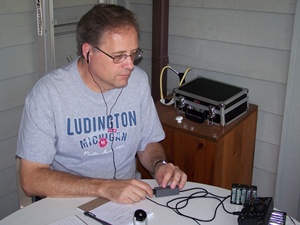 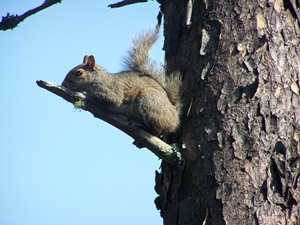 Exotic antennas like the Gieskieng, W3EDP end fed wire, W6TC loop, LB Cebik's interrupted loop, Rothammel's multiband loop and a rotatable fan dipole have been tried. None really satisfied me for one reason or another. Recently the search for a better antenna was rekindled after I came into possession of a Collins 180S-1 ATU, which made it possible to match almost anything. The present antenna is what I would call the "interrupted delta" and it seems to work OK in my location for 7 - 21 Mhz. Above 21 Mhz, the pattern starts to break up and below 7 Mhz it gets quickly inefficient (but I am still able to match 80 meters). Basically it is an inverted V that is end fed. It has radials for each band under the V, making it into an "interrupted" delta loop. The impedance on 30 meters was difficult to match and this was resolved by adding a second wire to the top. (I got this idea from Pete Mills M3KXZ). Hopefully the drawing speaks for itself and I include the impedance results as presented by MMANA and NEC-2. 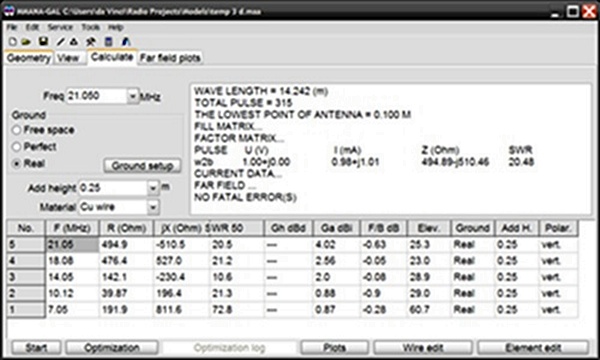 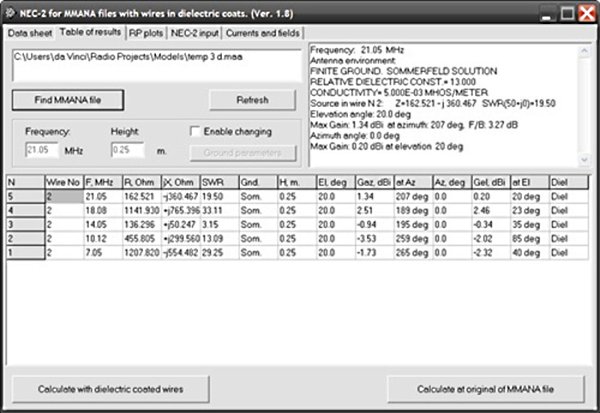 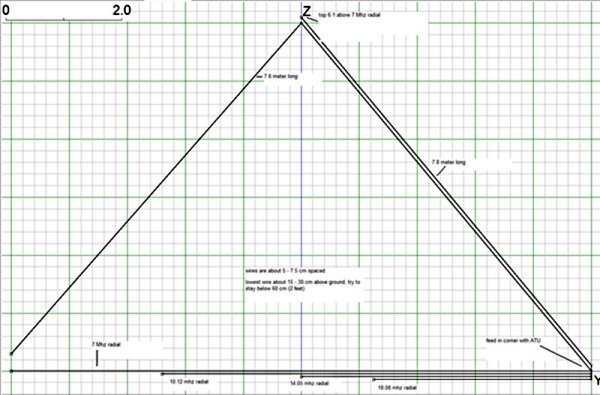 On Sunday morning, I packed up the K1 go-kit and headed for the Hook Peninsula. When I arrived, to my surprise, there were about 20 camper-vans peppered along the roadside where I had planned to operate. These guys weren't deterred by wind nor rain nor close quarters! So, I moved up the peninsula a wee bit and parked up in a small grassy area overlooking the sea. It had been a while since my last portable deployment, and I'd forgotten how hard it is to deploy even a small antenna in 30 knot winds! But, my "super" PAC-12 managed to get up without breakage and once the guy wires were tight, I knew it would stay up. I bought the standard PAC-12 kit and some extra parts from James Bennett (KA5DVS) at Dayton last May. Never being content to leave things alone I thought "bigger must be better" so I had added extra base pieces to make the stalk below the loading coil six feet long (guy wires now required). After a bit of coil and radial pruning, I got 40, 30, and 20 metres spot on. I use three quarter-wave(ish) tuned radials for each band made out of 1.5mm insulated wire. But I digress. After deploying the 30m coil and radial set, and a quick check with the watt meter, I was satisfied that all was correctly set up and ready for action. I proceeded to take a spin around the band, hearing lots of continental stations. So, 5w and a few CQs later, a F6FBN/QRP came back to me from near Brest, France, and gave me a 599 report. He was also 599 and (thankfully) quite patient with my paddle adjustment problems. Mental note, don't forget to bring the Palm Radio paddle next time! I went on to work a LY2, a LY3, and a DA before some of the bigger guns turned out on 116. I decided to start packing up for the day. Had I deployed either the 20 or 40 setup I probably could have worked a lot more stations but I was satisfied. A few contacts in the field are always better than a good day at work!! I returned to the comforts of home and a bit more QRP on a (bigger) vertical for the remainder of the evening. 40 metres was particularly good after dark and I wondered what if I'd gotten on 40 instead??? Our last HAM Radio in the Park was on July 26th. We had a total of 31 operators and 2 guests. Besides sweltering in the July heat, there were a number of other activities going on. Marina, KC5ZMY, got everyone started on a good caffeine and sugar rush with coffee and cinnamon rolls. Thank you Marina! The big highlight was the deployment of the Texas Baptist Men's Disaster Communications/Incident Command Center trailer with generator. This gave a number of members a chance to check out the trailer in a non-Field Day environment. The on-board VHF and UHF radios were placed in service and tested. The VHF low band radio for the Salvation Army was tested with a mobile contact with Jim, N5WYT. Some much needed repairs to the low band Ringo Ranger antenna were performed by Tim Lewis, KD6FWD. We also found out that the forward air conditioning unit needed servicing. I know our QRP crew was in full operation and even managed to snag some rare DX in James, KW5CW, in Balch Springs. I saw several HF wire antennas sprout up with Matt, KD5TAN, fielding a rather impressive mast set up. Lance, K7LDS, brought his ICOM 706 rig to be checked out. The date for the September HRitP will be the 26th at Samuell Farm. We hope to see you, or at least hear you, there. At the first meeting, a ceremonial signing of the license was conducted by myself, KM6NN as trustee, Doc NV4T (NAQCC #3805) as Boss HOG, Rob, N4PJX and Lewis, KF4WK (NAQCC #0700). During the meeting a ceremonial fund raising campaign was conducted and Doc presented the one and last donation of 1 cent. Then it was off to the Dog Hill District near downtown Clarksville. Lewis had brought his K-2 and his Buddy Pole antenna for our first QRP in the field QSO party. We set up the Buddy Pole for 40 meters and used a bench that is located on the walk way built by the City of Clarksville for local citizens to use. The walk way is real nice and makes a great place to operate. Setting up was a breeze and the antenna was up in no time. While Lewis and I set up the antenna, the Doc was hooking up the K-2 and power. With everything set up we were off and running on 40 meters. A quick scan of the band turned up only a few stations calling CQ. First we heard NI3F, Kenneth (NAQCC #2484) in Bethesda, MD. He was coming in strong so Doc sent out a call. No luck, so he tried again but still no contact. Doc moved on down the band to 7049 and we heard KB5GXD, Angelo in St. Joseph, MO. He was strong and also calling CQ. Doc set up and when Angelo stopped he jumped on him and called. We waited patiently and no return. Another call but still no contact. Oh well, so much for hunt and pounce. Now Doc started calling CQ and he called and called and called but no reply. Next I get on and start calling CQ. I call and call and call and no response. Then Lewis gets a turn. He calls and calls and calls and still no response. Now I an checking out the radio and the antenna but it all is set up FB. So Doc gets back on and he hears KF4YJQ calling CQ. Walter sounds strong and Doc gives him a call. Bingo !!!! Our first QSO for the Pigs is in the log. Doc receives a RST of 449 while Walter is a 589 to us. Turns out Walter is in Clarksville and lives not far from my house. It starts getting hot so we check one more time for a good signal but not much was going on. A weekday morning is not the most productive time for QRP but you never know who might be listening. It all is good in QRP country and we reluctantly shut down until the next QRP in the Field (story follows). 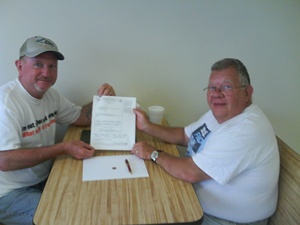 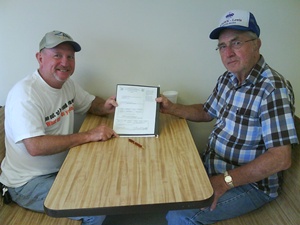 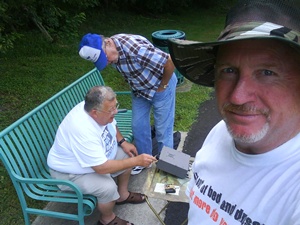 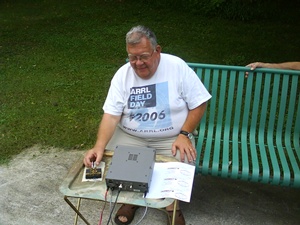 A Quest for the High Ground, Pilot Rock. After talking about locations for QRP operation at our local C.A.T.S. (Clarksville Amateur Transmitting Society) meeting, we were approached by Dan Baker, N4GXE. Dan was interested in our QRP activity and had a great suggestion for our next outing, Pilot Rock. I had heard of Pilot Rock from several persons in the radio club and they all talked about how many hams have done VHF work from that location. Now not being one to miss out on a good QRP location, Lewis and I talked about checking to see if we wanted to work a QRP in the Field from up on the Rock. Lewis has lived in the Clarksville area for many years and has visited Pilot Rock on more than one occasion. So with him at the wheel we were off and running to take a look. Pilot Rock is approximately 46 miles from Clarksville, near Hopkinsville Kentucky. If you use Google Earth, you can find it by a name search or by punching in the coordinates 36-55-17.82 North and 87-17-12.21 West. If that fails you can look for Hopkinsville KY and Pilot Rock is just to the North East of that city. You can see a sunset from Pilot Rock by clicking on the "Sunset from Pilot Rock" view. Moving right along we made our way to Hopkinsville Ky during the morning hours and only got lost one time. Once we found the right road, I got settled in when Lewis soon pulled off the side of the road and said "Here we are!". I got out of the truck and looked up the steep hill covered with brush and could just see some concrete steps going up into heavy brush. Off we went. The first part of the climb was not bad but as we went up we noticed that the walkway was cluttered with trees and had become overgrown with brush and poison ivy. Always keep an eye out for the plants with three leaves. The second part of the climb was also cluttered with downed trees and a big boulder that was sitting in a narrow walkway that I had to climb over to get to the top. Lewis decided to rest for a while and I moved on up the hill to the top where the view was great. No wonder a fire tower was put here (the tower is no longer as it was damaged by a storm, then torn down by the Forest Service). This is a great place to see for long distance and I think this will make a great place to work QRP. Now we just have to pack up all the gear, which is not all that heavy, and make a return visit. Check out our pictures and give a thought to visiting this High Ground in Kentucky. Check out Google and look at the sunset. It will make you think, "What a good place to work QRP". 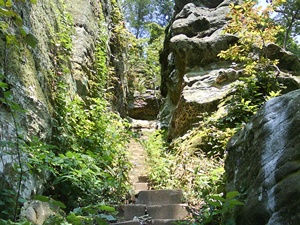 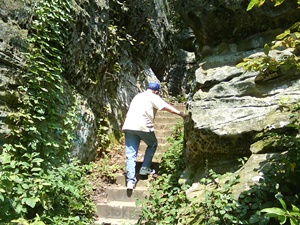 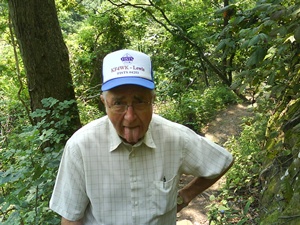 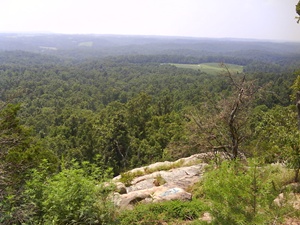 |
| The publication of our next newsletter will be announced via email to all members for whom we have a valid email address unless you specifically have unsubscribed from the email. Past on-line newsletters beginning with issue #042 are now archived on the site. So if you missed seeing any past issues, you can check them out in the archives. Unless otherwise credited, all items are written by K3WWP. If you came directly to this newsletter, we invite you now to browse the NAQCC Web Site. |